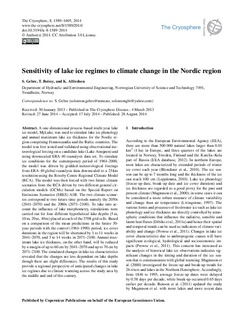| dc.contributor.author | Gebre, Solomon Bogale | |
| dc.contributor.author | Boissy, Thibault | |
| dc.contributor.author | Alfredsen, Knut | |
| dc.date.accessioned | 2015-09-22T11:07:25Z | |
| dc.date.accessioned | 2016-04-28T07:20:25Z | |
| dc.date.available | 2015-09-22T11:07:25Z | |
| dc.date.available | 2016-04-28T07:20:25Z | |
| dc.date.issued | 2014-08-28 | |
| dc.identifier.citation | The Cryosphere 2014, 8:1589-1605 | nb_NO |
| dc.identifier.issn | 1994-0424 | |
| dc.identifier.uri | http://hdl.handle.net/11250/2387707 | |
| dc.description.abstract | A one-dimensional process-based multi-year lake
ice model, MyLake, was used to simulate lake ice phenology
and annual maximum lake ice thickness for the Nordic region
comprising Fennoscandia and the Baltic countries. The
model was first tested and validated using observational meteorological
forcing on a candidate lake (Lake Atnsjøen) and
using downscaled ERA-40 reanalysis data set. To simulate
ice conditions for the contemporary period of 1961–2000,
the model was driven by gridded meteorological forcings
from ERA-40 global reanalysis data downscaled to a 25 km
resolution using the Rossby Centre Regional Climate Model
(RCA). The model was then forced with two future climate
scenarios from the RCA driven by two different general circulation
models (GCMs) based on the Special Report on
Emissions Scenarios (SRES) A1B. The two climate scenarios
correspond to two future time periods namely the 2050s
(2041–2070) and the 2080s (2071–2100). To take into account
the influence of lake morphometry, simulations were
carried out for four different hypothetical lake depths (5 m,
10 m, 20 m, 40 m) placed at each of the 3708 grid cells. Based
on a comparison of the mean predictions in the future 30-
year periods with the control (1961–1990) period, ice cover
durations in the region will be shortened by 1 to 11 weeks in
2041–2070, and 3 to 14 weeks in 2071–2100. Annual maximum
lake ice thickness, on the other hand, will be reduced
by a margin of up to 60 cm by 2041–2070 and up to 70 cm by
2071–2100. The simulated changes in lake ice characteristics
revealed that the changes are less dependent on lake depths
though there are slight differences. The results of this study
provide a regional perspective of anticipated changes in lake
ice regimes due to climate warming across the study area by
the middle and end of this century. | nb_NO |
| dc.language.iso | eng | nb_NO |
| dc.publisher | European Geosciences Union | nb_NO |
| dc.rights | Navngivelse 3.0 Norge | * |
| dc.rights.uri | http://creativecommons.org/licenses/by/3.0/no/ | * |
| dc.title | Sensitivity of lake ice regimes to climate change in the Nordic region | nb_NO |
| dc.type | Journal article | nb_NO |
| dc.type | Peer reviewed | nb_NO |
| dc.date.updated | 2015-09-22T11:07:25Z | |
| dc.source.pagenumber | 1589-1605 | nb_NO |
| dc.source.volume | 8 | nb_NO |
| dc.source.journal | The Cryosphere | nb_NO |
| dc.identifier.doi | 10.5194/tc-8-1589-2014 | |
| dc.identifier.cristin | 1150251 | |
| dc.relation.project | Norges forskningsråd: 193818 | nb_NO |
| dc.description.localcode | © Author(s) 2014. This work is Distributed under the Creative Commons Attribution 3.0 License. | nb_NO |

